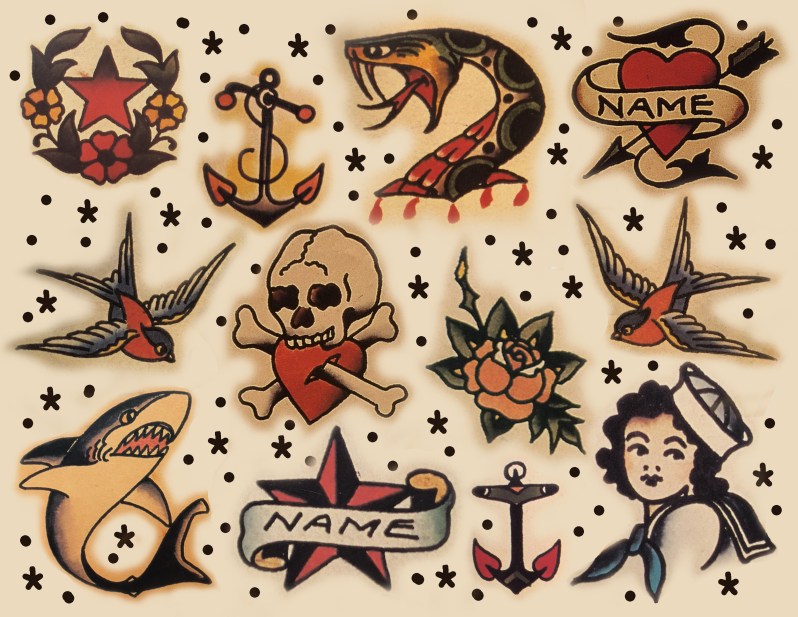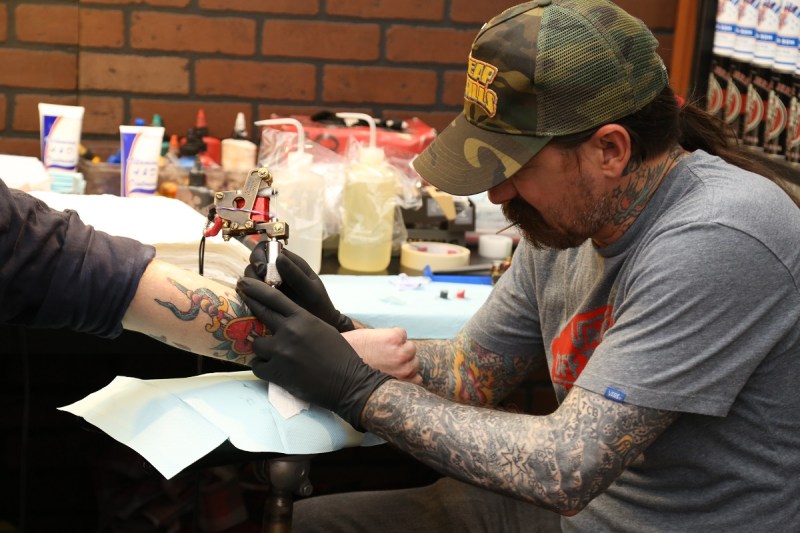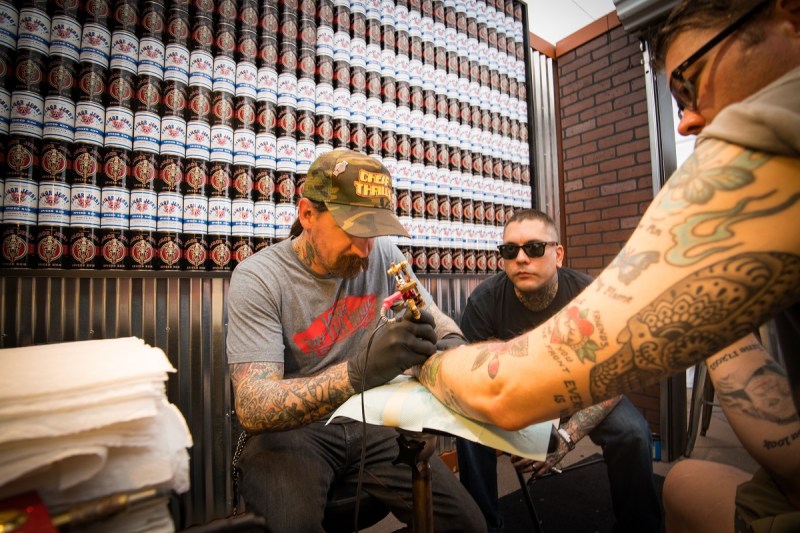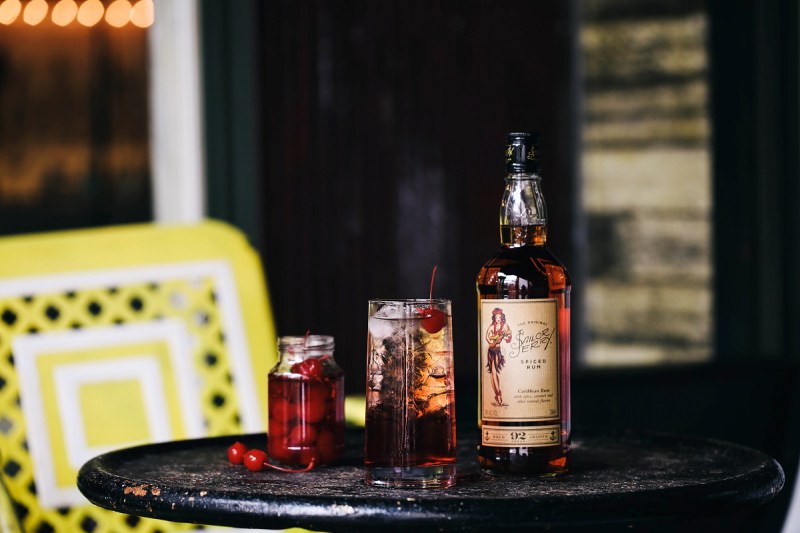The Background
Norman Keith Collins—who would later be known by his nickname, Sailor Jerry—was born January 14, 1911 in Reno, Nevada, though he spent his childhood years in Ukiah, California (about 150 miles northwest of Sacramento). As a child, he was given the nickname Jerry by his parents, who had a donkey of the same name. The donkey, true to its nature, was a bit of an ass, and so when Collins was young, his parents saddled him with the nickname. The Sailor part would come later, once Collins enlisted in the Navy.
The Beginning of His Art

Collins didn’t stay in Ukiah for long. When he was in his teens, Collins started riding the rails, hitchhiking his way around the country, following in the tracks of so many other people tired of going after the American Dream ideal that was omnipresent at the time. It was during this time that he was first introduced to the art of tattooing.
Collins began experimenting with the craft himself, working with whatever tools he could find and practicing on anyone who would be willing to let him (even paying bums in cheap wine to let him practice on them).
It needs to be noted here that when we say experimenting here, we don’t mean tattooing like you’d think of with a gun and pigments and, you know, tip-top sterilization. When Collins experimented with the craft, he was usually doing it with a needle and black ink to hand poke designs into people’s skin. (What would probably, in this day and age, be called “artisanal tattooing,” but is mostly known by the fun-sounding “stick-n-poke.”)
Eventually, Collins landed in the bustling metropolis that was 1920s Chicago. There, he met his first tattooing mentor, Gib “Tatts” Thomas, who taught Collins how to use a tattoo gun and, in the process, scared the shit out of him.
The story goes that Thomas took Collins to a morgue during the night shift so that he could practice on real skin. When they got there, Collins took hold of the arm, getting ready to tattoo the corpse. It was at this point that the corpse—that was not actually a corpse—sat up, scaring Collins, much to the delight of the others present.
After a few years of tattooing Navy cadets from the Great Lakes Naval Training Academy, Collins himself enlisted and was shipped off to various ports in Asia before landing in Hawai’i in the 1930s.
There, Collins continued working as a tattoo artist until 1941 when the Japanese bombed Pearl Harbor. Wanting to get back into the fray, Collins tried and was denied reenlistment, so instead he signed up for the Merchant Marines, allegedly working in Japanese waters for much of World War II.
When he got back to Hawai’i, it was, for all intents and purposes, a different world. Collins returned to tattooing and did so until the 1950s when the IRS fined him. As a symbolic middle finger to the government, Collins closed his shop and continued to tattoo in secret until he was convinced to come back to the business by another tattoo artist, Bob Palm.
Defining Tattoo Culture

During his career as a tattoo artist, Collins not only created iconic tattoo art that artists across the world reproduce today, but he also helped grow the art and craft of tattooing as a whole.
Among his greatest accomplishments, it is thanks to Collins that we have purple ink. Before Collins, tattoos were done in only a few colors—black, green, red, and yellow. Wanting to show up another local artist who often tried to piss Sailor Jerry off, Collins worked with a company to create what would be called carbazole violet, the first purple ink. For a long while, Collins only used the purple ink on those he felt earned it, swearing them to secrecy about its origin.
It is also thanks to him that single-use needles became a thing. On top of those monumental innovations in tattooing, Collins was one of the pioneers of using an autoclave to sterilize his equipment.
(In other words, if you’ve ever gotten a tattoo, or know someone who’s gotten a tattoo, you can thank Sailor Jerry for the fact that they did not die from infection.)
While busy defining tattooing as we know it, Collins was also cultivating relationships with tattoo artists across the world, creating art that still exists today. Notable among them were his Japanese-influenced pieces, which he learned in part from the “Horis” of Japan—the tattoo masters that, up until Sailor Jerry began communicating with them, kept their methods and ideas closed off from the world. Hori, an honorific title which means “to carve,” was bestowed on the Japanese tattoo masters. Collins, channeling all of the pranking that had been done on him and that he had done on others, gave himself the title Hori Smoku, which made fun of the fact that his Japanese compatriots could not say the phrase “Holy Smoke.”
The Next Generation

In addition to the Japanese Horis, Collins kept in touch with numerous other tattoo artists, including three other soon-to-be masters of the art, Ed Hardy (Yes, he was a real guy, too), Mike “Rollo” Malone, and Zeke Owen.
Collins kept tattooing in Hawai’i at his shop, located on Smith Street in the Chinatown section of Honolulu until 1972, when he went out in a way befitting the badass life that he led. He suffered a heart attack while riding his motorcycle, dying three days after the incident.
Before he died, though, he made his wife promise him one thing: if Hardy, Malone, or Owens would not buy his shop, he wanted it burned to the ground. Thankfully, Malone stepped up to purchase the shop. Malone would continue to tattoo in the shop (now named China Sea) for the next twenty-five years. Currently, the shop still exists under the name Old Ironside Tattoo, using the name Collins used as a moniker on a late-night radio show that he hosted to talk about politics, philosophy, and more.
…And a Bottle of Rum

In the late 90s, Hardy and Malone partnered with Steven Grasse of Philadelphia’s Quaker City Mercantile to create Sailor Jerry Ltd, a company that would produce art, clothing and, eventually, the rum that would come to bear Collins’ nickname. As with Collins own perfection when it came to creating his art, Hardy, Malone, and Grasse created the rum with that in mind—they wanted a product that Collins would be proud of.



